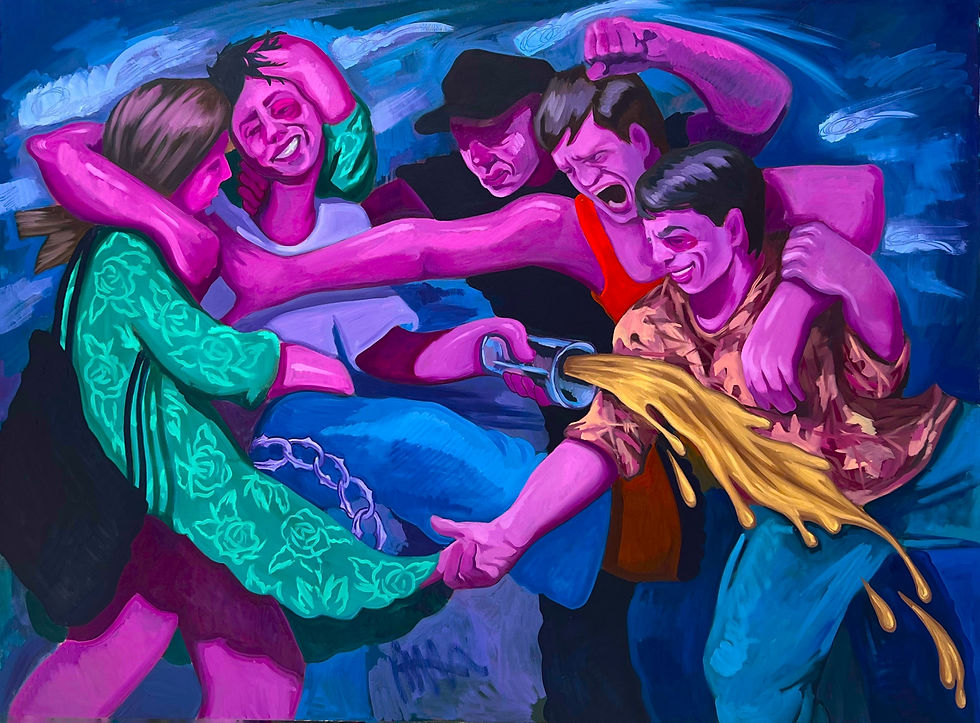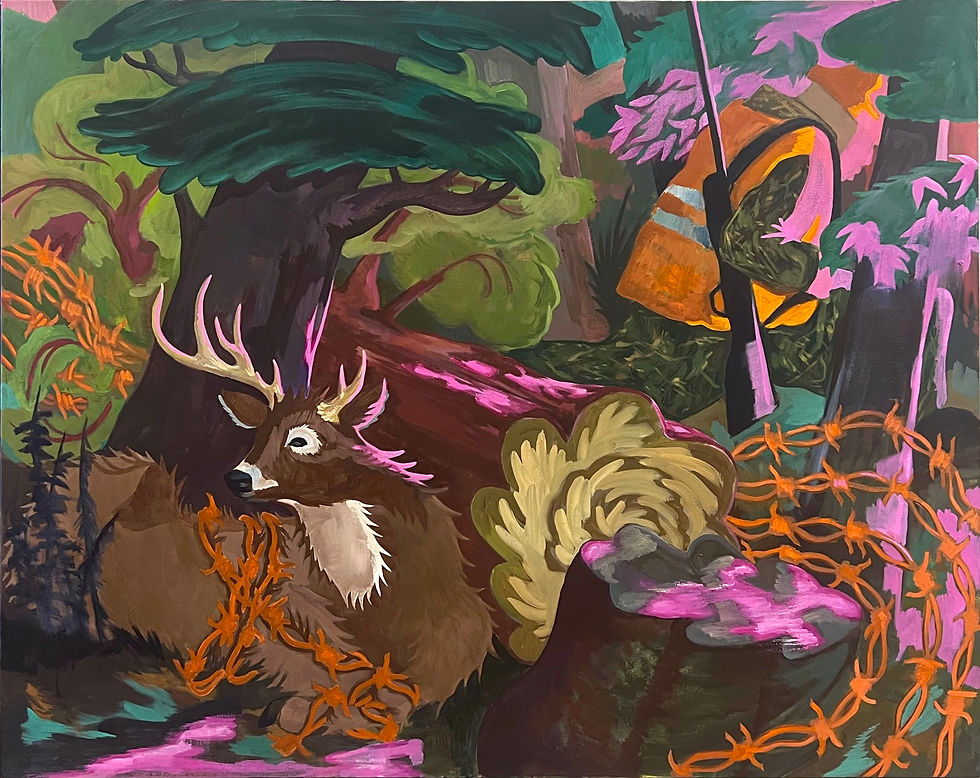Appalachian Artist Ceirra Evans: Painting The Beauty and Pain of A Misunderstood Region
- Information VOICE_TRIBUNE
- Mar 4
- 4 min read
By Alisha Proffitt • Portrait Photos By Matt Johnson Artwork Photos Provided By ceirraevans.com

Born and raised in Owingsville, Ceirra Evans is a Kentucky-based painter whose work is deeply rooted in the landscapes and narratives of Appalachia and the working-class South. Earning her BA from Spalding University in 2021, her paintings often blend oil painting, folk art, and illustration traditions. Her work has been featured in major publications like The New Yorker and Hyperallergic. Evans’ recent solo exhibitions include Come Home With Me at Virginia Tech’s Perspective Gallery, A Wild Weed at Galerie Geraldine Banier in Paris, and Be Careful Out There at Moremen Gallery in Louisville. Her latest work was featured in the group exhibition Queer Art | Queer Archives at the University of Kentucky’s Bolivar Gallery. Evans’ paintings are in private collections in the U.S. and the UK, as well as in the permanent collection of the Speed Art Museum.
Evans’ art often tackles the complicated emotional polarities that occur when the place you grow is a source of both comfort and pain. In true Appalachian tradition, each of Evans’ paintings has its own story to tell. “Storytelling is at the core of my practice. It’s how I explain myself and connect with others. Most of my work begins with a piece of a story, an anecdote, or a conversation. From there, I decide how far to push the narrative, and what the painting ultimately reveals. It’s always deeply personal but also a reflection of the larger community,” says Evans.

Many of these stories are reflections of Evans’ childhood and personal experiences. “My childhood in Eastern Kentucky is filled with vivid, complex memories that can feel irreverent but also warm,” she reflects. “As the youngest in the house and my mother’s sidekick, I observed a lot– the people who came and went, their tattoos, scars, the way they carried themselves, and the work they did. Those moments have shaped my understanding of people and place, and I carry those stories with me into my art.”
Evans’ paintings critique perceptions of Appalachia and the South, challenging misconceptions about the region. “Appalachia and the South are often written out, misunderstood, and unfairly labeled as politically backward or as home to ‘bad people. ’That’s horses**t,” she says. “I challenge this perception by highlighting the diversity, artistry, and resilience that thrive in the Region.” A primary focus in her art is addiction, particularly in Appalachia. “It gets oversimplified as a ‘regional problem.’ The truth is that addiction is a multi-faceted issue, and it’s exacerbated by corporate greed,” she explains. “My work pushes against these one-dimensional narratives, offering a more nuanced view of both the struggles and the resilience of the people here.”

Humor occasionally plays a role in Evans’ art, adding or taking away depending on whether it serves the story. “I’ve learned that humor helps maintain humility in the process and adds an element of humanity to heavier topics. When it comes to generational poverty and addiction, I draw from my personal experiences, never using humor to judge or trivialize. Instead, it’s a way of reflecting on life’s hardships with honesty, sometimes laughing at myself and those closest to me along the way.”
Beyond the place she calls home, Evans draws artistic inspiration from art itself. “I’m inspired by a wide range of artists. Nicole Eisenman, for example, has always been a major influence. Her boldness in creating large, unapologetic works motivates how I approach my own paintings,” shares Evans. “Thomas Hart Benton’s dynamic movement and storytelling is another key influence. More recently, I’ve found myself returning to Alexandre Hogue, a member of the Dallas Nine. His work, which often tells stories of the Dust Bowl and land degradation, has inspired the way I use light to convey depth and narrative.” Influences also include the work of the Kinney and Tolson families “Their storytelling is straightforward yet deeply personal, something I strive for in my own work. I’m continually drawing from regional artists and folk-art traditions, working to bring these influences into my practice.”

Evans’ work is part of the Speed Art Museum’s permanent collection, an institution that holds a special place in her heart. “It was the first fine art museum I ever visited, at age 16, during Governor’s School for the Arts. Working at the Speed from late 2018 to 2022 deepened my appreciation for museums and their role in preserving history. Having my work exhibited there is both an honor and a full circle moment. I hope it helps pave the way for more diverse Appalachian artists to be recognized and celebrated in major collections. Our stories deserve to be told.”

Access to representation and diversity in art helps us to better understand ourselves and those around us. Evans’ work illustrates the unique perspective of life in rural Appalachia and the South from a queer lens, without being put in a box. “Appalachia lends itself to being queer. It’s a sentiment that other folks from the region and I talk about often. Queerness isn’t just about sex or gender, it’s about living in a non-traditional way. I am a butch woman and will always say that my butchness has been inspired by other working-class women of the region. They may not have led a “genderqueer” life, but they carry themselves as a challenge to the status quo with strength, discipline and charm,” she says, “Being seen as a queer, Appalachian artist does make me uncomfortable to a degree. I don’t want the conversation around queerness and Appalachia to be trite. However, these degrees have helped me understand how important it is to speak about the existence of queerness within the region. It’s important to the younger generation to see queer adults living, thriving, and fighting.”
For those unfamiliar with Ceirra’s work, she offers these closing sentiments -“I would hope that viewers engage with my work by leaning into any discomfort or confusion it might stir up. For my queer Appalachian folks, I hope they find a sense of home in my paintings, a place where their experiences and identities are validated and celebrated.”






Comments